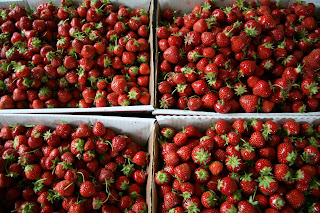
I've had the luck to find wild blueberries twice this summer, once at the farmer's market a few weeks ago, where Jon grudgingly allowed me to fork over a small fortune for a pint, and last Thursday in my CSA share. Our CSA, the Farm Direct Coop, is amazing. Last year was our first experience with a CSA share, and we were somewhat disappointed. The weekly pick up yielded far too much lettuce and greens, which never looked very fresh/appetizing, and hardly any fruit. The lack of fruit was somewhat excusable, as I didn't really notice that this particular CSA was a vegetable share when we signed up, so I supposed I should have been happily surprised when we got any. The CSA was in it's first year, so I am sure it will get better. However, when when the FDC was able to open up more shares this year, we moved up off the waiting list and signed up. They have separate fruit and vegetable shares, and even offer a local cheese share. Everything has been absolutely top notch thus far, and a few things were really amazing, including the pea tendrils, strawberries, peaches and the wild blueberries. The first pint of blueberries I bought I mixed with normal, highbush variety to make a pie (not being quite extravagant enough to buy several pints). Somehow, the crust I made did not turn well. Recently I decided to switch from an all-butter pastry dough to a part shortening variety. I think I was overtly conscious of the humidity that day, and simply did not add enough water to the dough, and it would not stick together when I rolled it out. Subsequently, the crust was flavorful, but not at all flaky, and the top was sort of pieced together in spots. I decided to give it another go this weekend, and it turned out much better. I do think the pie would be over-the-top if made entirely with the wild berries - too bad I don't have any birthdays in July.
Wild Blueberry Pie
Pastry Crust (doubled-crusted pie)
2 1/2C. all-purpose flour
1/2t. salt
12T. unsalted butter, cold
1/4C. shortening, cold
4-6T. ice water
Place flour and salt in a large food processor; pulse until mixed. Cut butter into ~1/2inch chunks and add to processor. Add shortening in ~4 spoonfuls over flour mixture. Pulse just until pea-sized chunks of butter and shortening are still visible. Sprinkle 4T. ice water over mixture. Pulse until mixture just starts to come together. Squeeze a handful of dough to see if it sticks together; if it still appears crumbly/your hand appears dusty, repeat, adding ice water 1T. at a time. When mixture holds together, pour onto counter top and smear with the palm of your hand until entire mixture is smeared. Scrape into 2 balls of dough, one slightly larger (this will be the bottom crust), and form ~1inch disks. Refrigerate at least 1h, up to 24h.
Filling
30oz. blueberries (I used 12oz. wild berries, and the remainder highbush berries; ~6C. total)
1T. lemon juice (~1/2 lemon)
1C. sugar
2T. all-purpose flour
2T. cornstarch
Place a large jelly roll pan/cookie sheet in oven and preheat to 425 (preheating the cookie sheet will enable the bottom crust to crisp better). Mix berries in a large bowl. Sprinkle with lemon juice. Mix remaining ingredients in a separate bowl, then toss with berries. Roll out large piece of dough. Place in a 9inch pie dish, then place in fridge while rolling out the top crust. Roll out top crust, and cut decorative holes if desired. Remove bottom crust from fridge, then add berries. Place crust on top, and crimp edges. If you want a glossy, browned crust, whisk an egg with 1T. water, and brush lightly over top. Bake for 45-60 minutes, or until berries are bubbling in center of pie. Check periodically to make sure crust is not browning too much, and cover with foil if necessary. Cool at least 1h on rack before serving (this will help set the filling).









